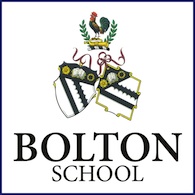Ten Facts about Bolton School
It is often said that you never appreciate fully what you live with at close quarters. Tourists will flock to a particular location to admire it, whilst those who live there will be oblivious to its attractions.
This set of 10 facts about Bolton School are intended as a starter to hep understand the significance of what we have all become used to.
1)ááááá Bolton is a very old school. People have been educated in Bolton, as a means of raising aspirations, for a very long time. We are about to celebrate our 500th anniversary. Founded in 1516 it is in the top 80 oldest schools in the UK, which arguably has some of the longest standing school Foundations in the world. It is one of the top 10 oldest schools in the North of England. The buildings, endowed by Leverhulme, are a unique feature.
2)ááááá Bolton is a very large school. It is one of the top five school Foundations in terms of overall size, with more than 2250 boys and girls on site. In terms of pupil numbers, the BoysÆ Division is one of the top 5 largest independent day schools for boys in the UK. The GirlsÆ Division is one of the top 15 largest independent day schools for girls in the UK.
3)ááááá Bolton is a thriving school. Between 2007 and 2014 independent school numbers in the North of England fell by 12%. Over that time at Bolton they rose by nearly 1%.A recent study by the Oxford Centre for Economics found that the school contributes ú17 million to the NW economy. The school estimates a charitable contribution to community engagement of around ú75k per year, with another ú30k of fund raising by pupils.
4)ááááá Bolton School also has one of the most significant bursary fund commitments of any school in the UK, with 1 in 5 pupils receiving financial support. National surveys show we are a leading school in allocating those funds to the least well off, so promoting social mobility.
5)ááááá As single sex schools, side by side, Bolton School educates a good proportion of those nationally in Independent Single Sex Day schools. There are just over 100,000 boys as day pupils in the 250 HMC schools. Bolton educates over 1000 of them, around 1%. We are a significant participant and source of expertise nationally in single sex selective education.
6)ááááá Bolton School is regularly in the top 100 of the most widely accepted league tables that focus on results and value added. Usually some 25 schools in the north of England regularly reach that standard.
7) á á áThere have been around 90 UK educated nobel prize winners, educated at some 80 different schools. Bolton School is one of those and one of only ten in the north of England.
8)ááááá Bolton School pupils go on to make a difference in the world, which is recognised by society at large in a variety of ways. At present there are 2 Baronesses, 1 Baron, 5 knights and a Dame amongst the Alumni, as well as nearly 20 who have been recognised with CBE, OBE or MBE. Half a dozen are currently Fellows of the Royal Society (FRS).
9)ááááá This contribution to society continues with current pupils. Last year some 10,000 volunteering hours were committed by the sixth form, who were nationally recognised attending the VInspired awards.
10)áá Bolton School is known nationally for outdoor learning, its sporting excellence and focus on participation. That reflects in alumni having made careers in cricket, football, rugby, water polo and swimming in the last decade and before. It also reflects in our nationally recognised primary outreach programme across all Bolton Schools.

Very interesting set of facts. I didn’t know some of them, such as that Bolton is one of the largest single foundation schools. We need to spread the messages in Bolton, there are any local people whose paths have never led them to iBolton School in any capacity, and who may have misconceptions about what it is all about.